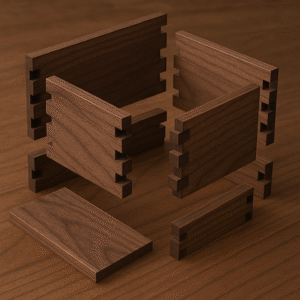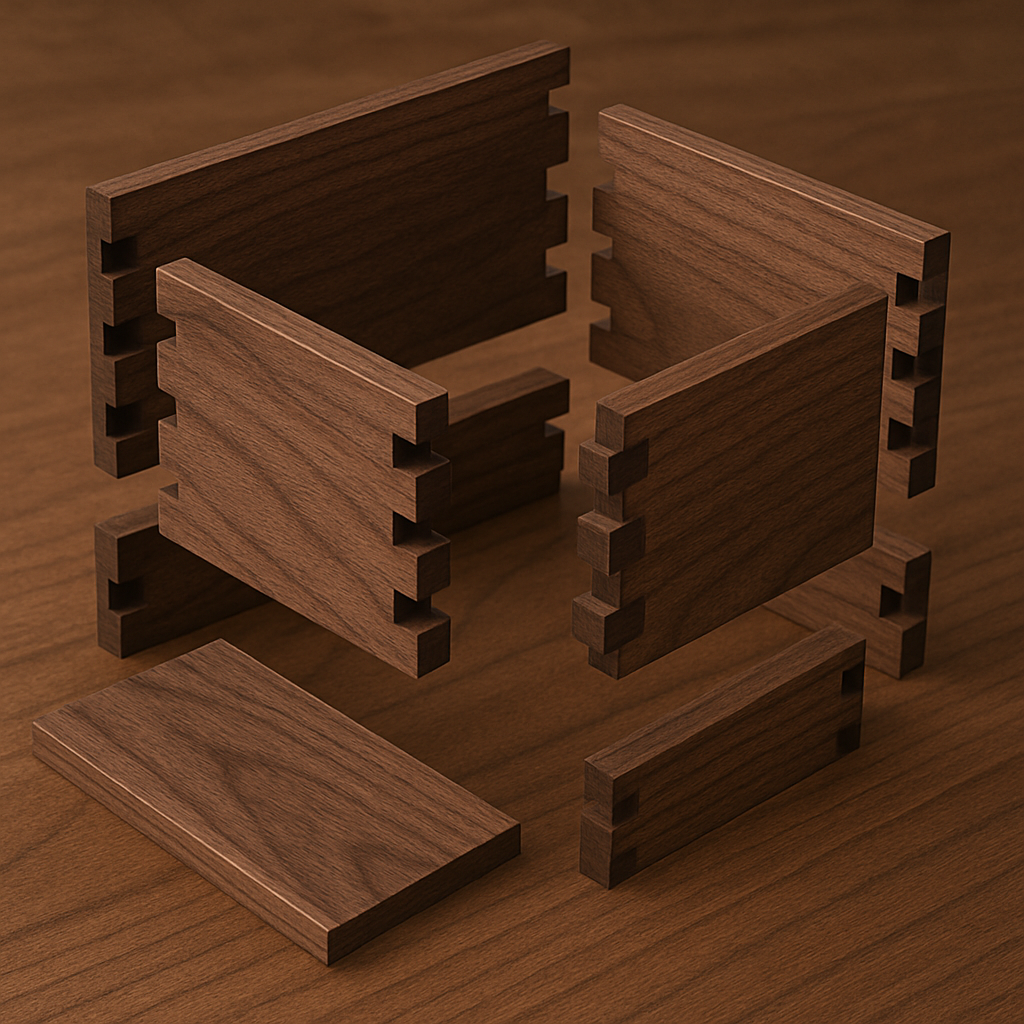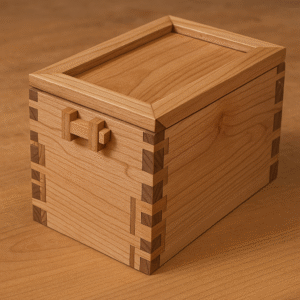
Dovetail joints hold a special place in woodworking history, thanks to their strength and beauty. These little wonders have been around for ages, popping up in ancient Egyptian furniture all the way to modern cabinetry. They’re like the timeless classics of the woodworking world — always in style. Mastering the art of dovetail joints is all about helping others learn and master this great skill.
Ever wondered why dovetail joints get the all-star treatment? It’s because they perfectly blend form and function. They offer serious stability because of their interlocking design. That means they’re not just pretty to look at; they’re built to last. Getting them right is a major achievement for any woodworker and a true badge of honor.
In this guide, I’ll walk you through the ins and outs of mastering the art of dovetail joints. You’ll find everything from basic techniques to pro tips and explore common challenges and how to solve them. Plus, we’ll delve into the secret dovetail joint — a mysterious variant that can elevate your woodworking game. Get ready to transform your crafting skills, one dovetail at a time!
The Basics of Crafting Dovetail Joints
Crafting your first dovetail joint can feel like setting out on a thrilling adventure. But don’t worry, I’ve got a step-by-step guide that’ll make the process less daunting. Start by selecting the right wood. Softer woods like pine are forgiving and make them ideal for beginners. Get your hands on some quality woodworking tools, like a sharp chisel and dovetail saw. Trust me, good tools make all the difference. Draw out your dovetail layout on the wood with precision before any cutting starts.
It’s all about setting up your workspace right. Ensure you have good lighting and a stable workbench to avoid any mishaps. And don’t rush. Taking your time to cut each angle meticulously will pay off in the end. Focus on using consistent pressure and maintaining steady hands when using the saw for those straight and clean cuts.
Don’t forget that practice makes perfect. Those first few joints might not be perfect, but each one will teach you something new. Embrace those early mistakes as invaluable lessons on your way to mastery. And remember, viewing online tutorials or joining a woodworking class can be a great way to gain confidence.
Starting with simple projects, like small boxes or basic drawers, is smart. These will give you enough room to hone your skills without feeling overwhelmed. Once you’ve nailed the smaller projects, move on to more complex pieces. The key is to challenge yourself but keep it enjoyable.
By the end of your first sessions, you’ll start feeling the rhythm of crafting, and your hands will become attuned to the tools and materials. It’s a journey worth embarking on, transforming raw wood into something truly special.
** Here’s a little transparency: Our website contains affiliate links. This means if you click and make a purchase, we may receive a small commission. Don’t worry, there’s no extra cost to you. It’s a simple way you can support our mission to bring you quality content.**
Mastering Techniques and Improving Skills
Improving at dovetail joints is all about what you put in. More practice equals more polish on your skills. It’s pretty simple—regular practice is like watering a plant. It grows your ability and boosts your confidence.
- Aim to practice regularly, even if it’s just a few short sessions a week. Try to challenge yourself with more complex designs as you progress. This keeps things fresh and tests the techniques you’ve learned.
- Precision is key in any dovetail work. Make sure every pencil line, every cut is as accurate as possible. Double-check your measurements. This might sound basic, but these details really matter when you’re going for that perfect fit.
- When practice doesn’t go as planned, it’s easy to get disheartened. Mistakes are a part of the process. Look at them as hints on what needs a little more attention. Keep note of what didn’t work out, fix it, and you’ll start seeing progress in no time.
- Diversifying the types of dovetails you work on helps keep your skills sharp. Don’t stick to one style. Experiment with different cuts and patterns to see what feels best and what provides the functionality you need.
- It’s not just the hands-on work either. Watching video tutorials, reading articles, or attending workshops can introduce you to new techniques and tips that you hadn’t considered before. There’s always something new to learn or a skill to refine.
By sticking to these techniques and maintaining a focus on improvement, your dovetail joints will not only become more accurate but also a reflection of your creative capabilities and dedication. These tips are about building your skill one dovetail joint at a time, nudging you towards mastery.
Challenges and Limitations of Dovetail Joints
Dovetail joints, while beautiful and sturdy, do come with their own set of challenges. One of the biggest hurdles is the complexity involved. Crafting a dovetail joint requires precision and a steady hand. If you’re not paying close attention, it’s easy to make a mess of it. The learning curve can be steep, but don’t let that deter you. Persistence will eventually pay off.
Another downside is the time involved in crafting these joints. Unlike straightforward joints, dovetails demand a lot more time and patience for proper execution. For those pressed for time, this can be a drawback. However, the investment often pays off with the durability and visual appeal the dovetails add to your pieces.
There are certain situations where dovetail joints might not be your best bet. For example, if you’re working on projects where speed is critical or where the joints won’t be exposed to much stress, simpler methods might be more efficient. It’s about matching your joint style with your project needs.
While they’re often seen as a mark of quality in woodworking, it’s crucial to balance aesthetics with functionality. If a particular project doesn’t call for such intricate joinery, there’s no harm in choosing a simpler route. This way, you can ensure the piece serves its purpose without unnecessary complexity.
Amazon has everything you will need to get you started on mastering
the art of dovetail joints.
As an Amazon Associate, I earn from qualifying purchases.
Here is a list of some handy tools that will have you producing professional high-quality dovetail joints every time:
-
Dovetail Jig & Wheel Marking Gauge
-
Wheel Marking Gauge
-
Mortise Gauge Woodworking Marking Gauge
-
Dovetail Jig Wheel Marking Gauge
-
Woodworking Dovetail Jig
-
Dovetail Marker
-
Double Bevel Striking Marking Knife
-
Scriber Gauge 8 Inch – Precision Marking & Measuring Tool
-
Dovetail Jigs for Woodworking
-
Dovetail Guide, Flat Leg Spring Marking Gauge
Advanced Dovetailing: The Secret Dovetail Joint and More
Delving into advanced techniques can take your woodworking to a new level. One intriguing method is the secret dovetail joint. It’s like having an ace up your sleeve — hidden but incredibly effective. This joint lets you enjoy the clean look of a plain corner with the hidden strength of dovetails holding everything together.
Creating a secret dovetail requires a sharp eye and a lot of patience. The outer layer hides dovetail connections, giving the piece a seamless appearance. The effort is definitely worth it for that wow factor when someone discovers the sturdy secret behind the clean design.
Getting accurate dovetails at any level means refining your measuring and cutting techniques. Double-check all your angles and lines before making a cut. Sharp tools are a must, too; they make smooth, clean edges that fit together without gaps.
Keep experimenting with different dovetail styles such as half-blind, through, and sliding dovetails. Trying out various types challenges you and helps develop your skills further. Plus, it allows you to find what you enjoy most and what works best for each project.
Taking the step into advanced dovetailing isn’t just about mastering a skill — it’s about discovering new, creative ways to bring your designs to life. With practice and a bit of curiosity, these advanced techniques offer endless possibilities and challenges. This is where you take everything you’ve learned and really start showing off your woodworking prowess.
Happy building!
Here’s another great source for Mastering dovetail joints:





